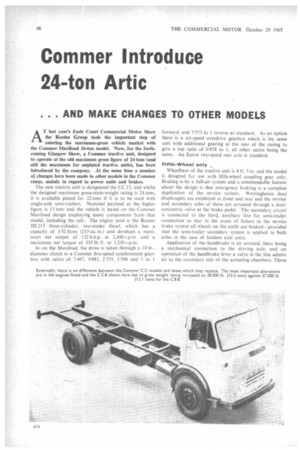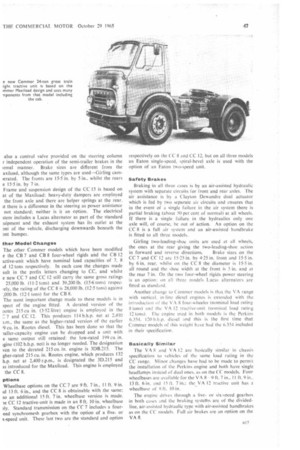Commer Introduce 24-ton Artic
Page 48

Page 49

If you've noticed an error in this article please click here to report it so we can fix it.
AND MAKE CHANGES TO OTHER MODELS
AT last year's Earls Court Commercial Motor Show the Rooks Group took the important step of entering the maximum-gross vehicle market with the Commer Maxiload 16-ton model. Now, for the forthcoming Glasgow Show, a Commer tractive unit, designed to operate at the old maximum gross figure of 24 tons (and still the maximum for unplated tractive units), has been introduced by the company. At the same time a number of, changes have been made to other models in the Commer range, mainly in regard to power units and brakes.
The new tractive unit is designated the CC 15, and whilst the designed maximum gross-train-weight rating is 24 tons, it is available plated for 22 tons if it is to be used with single-axle semi-trailers. Nominal payload at the higher figure is 15 tons and the vehicle is based on the Commer Maxiload design employing many components from that model, including the cab. The engine used is the Rootes 3D.215 three-cylinder, two-stroke diesel, which has a capacity of 3.52 litres (215 Cu. in.) and develops a maximum net output of 132 b.h.p. at 2,400 r.p.m. and a maximum net torque of 335 lb. ft. at 1,250 r.p.m.
As on the Maxiload, the drive is taken through a 14 in.diameter clutch to a Commer five-speed synchromesh gearbox with ratios of 7.497, 3.983, 2.555, 1.590 and 1 to 1 forward, and 7.573 to 1 reverse as standard. As an option there is a six-speed overdrive gearbox which is the same unit with additional gearing at the rear of the casing to give a top ratio of 0.878 to 1, all other ratios being the same. An Eaton two-speed rear axle is standard.
Fifth-Wheel only
Wheelbase of the tractive unit is 8 ft. 5 in, and the model is designed for use with fifth-wheel coupling gear only. Braking is by a full-air system and a commendable feature about the design is that emergency braking is a complete duplication of the service system. Westinghouse dual diaphragms are employed at front and rear and the service and secondary sides of these are actuated through a dualconcentric valve at the brake pedal. The secondary circuit is connected to the third, auxiliary line for semi-trailer connection so that in the event of failure in the service brake system all wheels on the outfit are braked—provided that the semi-trailer secondary system is applied to both axles in the case of tandem axle units.
Application of the handbrake is air assisted, there being a mechanical connection to the driving axle, and on operation of the handbrake lever a valve in the line admits air to the secondary side of the actuating chambers. There also a control valve provided on the steering column r independent operation of the semi-trailer brakes in the irmal manner. Brake sizes are different from the axiload, although the same types are used--Girling camierated. The fronts are 15.5 in. by 5 in.. whilst the rears e 15.5 in. by 7 in.
Frame and suspension design of the CC 15 is based on at of the Maxiload: heavy-duty dampers are employed the front axle and there are helper springs at the rear. it there is a difference in the steering as power assistance not standard: neither is it an option. The electrical stem includes a Lucas alternator as part of the standard luipment and the exhaust system has its outlet at the Dnt of the vehicle, discharging downwards beneath the ant bumpei.
ther Model Changes The other Commer models which have been modified e the CB 7 and CB 8 four-wheel rigids and the CB 12 ictive-unit which have nominal load capacities of 7. 8
id 12 tons respectively. In each case the changes made suit in the prefix letters changing to CC, and whilst
e new CC 7 and CC 12 still carry the same gross ratings 25,000 lb. (11.2 tons) and 39,200 lb. (15-6 tons) respecrely, the rating of the CC 8 is 28,000 lb. (12-5 tons) against ,000 lb. (12-1 tons) for the CB 8.
The most important change made to these models is in spect of the engine fitted. A derated version of the ootes 215 cu. in. (3-52 litre) engine is employed in the 2. 7 and CC 12. This produces 114 b.h.p. net at 2,490
).m., the same as the higher-rated version of the earlier ,9 cu. in. Rootes diesel. This has been done so that the laller-capacity engine can be dropped and a unit with e same output still retained: the low-rated 199 Cu. in. igine (102 b.h.p. net) is no longer needed. The designation ven to the derated 215 cu. in. engine is 3DB.215. The gher-rated 215 Cu. in. Rootes engine, which produces 132 h.p. net at 2,400 r.p.m., is designated the 3D.2I5 and as introduced for the Maxiload. This engine is employed the CC 8.
ptions Wheelbase options on the CC 7 are 9 ft. 7 in., 11 ft. 9 in.
id 13 ft. 6 in., and the CC 8 is obtainable with the same: so an additional 15 ft. 7 in. wheelbase version is made. le CC 12 tractive-unit is made in an 8 ft. 10 in. wheelbase sly. Standard transmission on the CC 7 includes a fourted synchromesh gearbox with the option of a fiveor c-speed unit. These last two are the standard and option
respectively on the CC 8 and CC 12, but on all three models an Eaton single-speed, spiral-bevel axle is used with the option of an Eaton two-speed unit.
Safety Brakes
Braking in all three cases is by an air-assisted hydraulic system with separate circuits for front and rear axles. The air assistance is by a Clayton Dewandre dual actuator which is fed by two separate air circuits and ensures that in the event of a single failure in the air system there is partial braking (about 50 per cent of normal) at all wheels. If there is a single failure in the hydraulics only one axle will, of course, be out of action. An option on the CC 8 is a full air system and an air-assisted handbrake is fitted to all three models.
Girling two-leading-shoe units are used at all wheels, the ones at the rear giving the two-leading-shoe action
in forward and reverse directions. Brake sizes on the CC 7 and CC 12 are 15-25 in. by 4.25 in. front and 15-5 in. by 6 in. rear, whilst on the CC 8 the diameter is 15-5 in. all round and the shoe width at the front is Sin, and at the rear 7 in. On the two four-wheel rigids power steering is an option: on all three models Lucas alternators are fitted as standard.
Another change to Comfier models is that, the VA range with vertical, in-line diesel engines is extended with the introduction of the VA 8 four-wheeler (nominal load rating 8 tons) and the VA 12 tractive-unit (nominal load rating 12 tons). The engine used in both models is the Perkins 6.354. 120 b.h.p. diesel and this is the first time that Commer models of this weight have had the 6.354 included in their specification.
Basically Similar
The VA 8 and VA 12 are basically similar in chassis specification to vehicles of the same load rating in the CC range. Minor changes have had to he made to permit the installation of the Perkins engine and both have single headlamps instead of dual ones, as on the CC models, Four wheelbases are available for the VA 8.. 9 ft. 7 in., II ft. 9 in.,
13 ft. 6 in. and 15 ft. 7 in.: the VA 12 tractive unit has a wheelbase of 8 ft. 10 in.
The engine drives through a fiveor six-sPeed gearbox in both cases and the braking systeens are of the dividedline, air-assisted hydraulic type with air-assisted handbrakes as on the CC models. Full air brakes are an option on the VA R.




















































































































